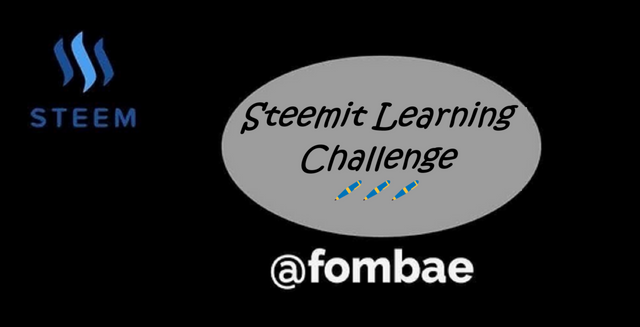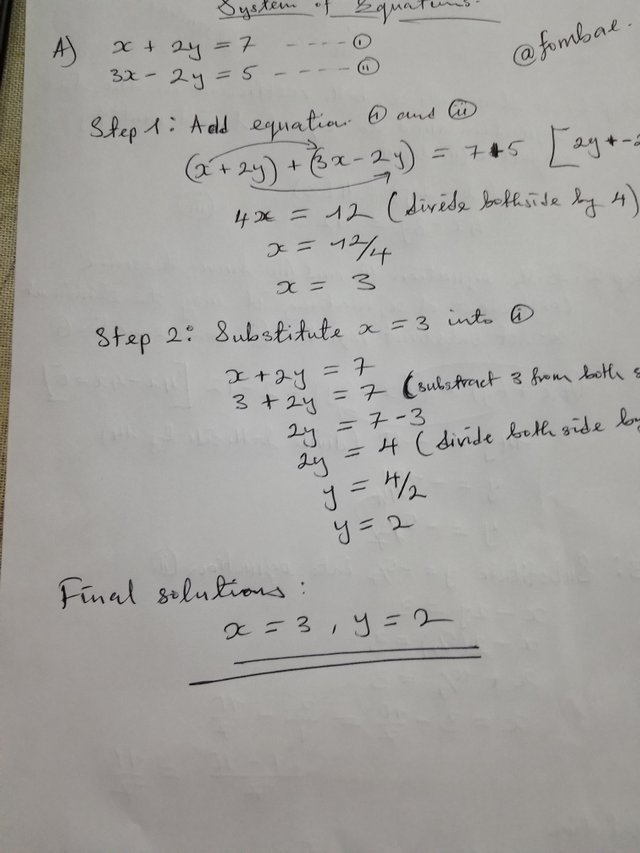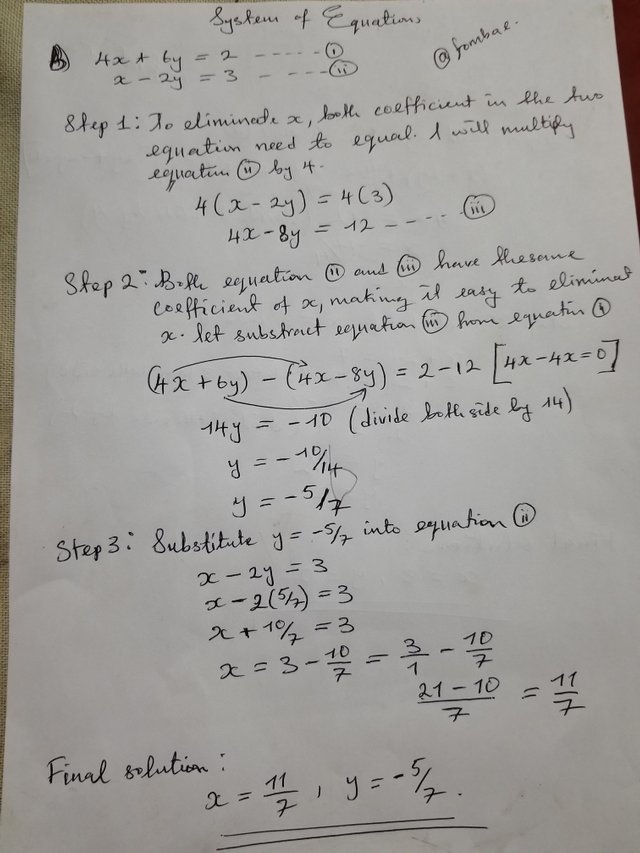SLC-S22W3//Equations and Systems of equations.

Greetings Steemit friends
Explain the difference between linear and nonlinear systems of equations. Provide examples of each type of system of equations and describe their general forms.
Looking at the difference between linear and nonlinear systems of equations, which is highlighted already in the course.
Linear Systems of Equations: These systems are where each variable in the equations is raised to the power of 1 and represents a straight line when plotted on a graph.
general Form
ax + by + c = 0
dx + ey + f = 0
Here a, b, c, d, e, and f are the constants.
Example :
2x + y = 6
2x - y = 4
The linear system can be solved by substitution, elimination, or graphically.
Nonlinear Systems of Equations: This system is where at least one equation is not linear, meaning a variable is raised to a power greater than 1. Examples are quadratic and exponential equations, etc. When plotting nonlinear systems on a graph, we have a parabola shape.
General form
f(x,y) = 0
g(x,y)= 0
Here f(x,y) and g(x,y) are the nonlinear expressions.
Example:
x^2 + y^2 = 25
x = y = 9
Nonlinear systems can be solved by substitution, elimination, or numerical methods.
Describe any one method for solving a system of linear equations and share at least one step-by-step algebraic example. (It should be other than substitution, elimination, and graphing methods)
One method of solving linear equations is the matrix method, making use of augmented matrix and carry-row operations. I will try to explain what I'm doing. The solution is broken down into four.
- Represent the equation in matrix form
- Perform row operation
- simply the matrix
- Substitution
- System of equations
x + y + z = 6
2x + 3y + z = 14
y + 2z =8
Let's represent the equation in matrix form.
| 1 1 1 6| R1
| 2 3 1 14| R2
| 0 1 2 8| R3
Let's perform a row operation. I will try slowly here. We swap two rows, multiply by a non-zero scalar and finally add or subtract a multiple of one row to another.
Step 1: We are going to eliminate the first of R2 (which is 2) and make it equal to zero. For us to achieve that, we need to multiply the elements in row 1 by 2(the first element in R2).
2 × [ 1 1 1 6 ] = [ 2 2 2 12 ]
Now, we subtract the result from R2.
[ 2 3 1 14 ] − [ 2 2 2 12 ] = [ 0 1 −1 2 ]
Let's update our matrix form.
| 1 1 1 6 | R1
| 0 1 -1 2 | R2 (has changed, and the first element is equal to 0)
| 0 1 2 8 | R3
Step 2: We move to the next row, R3. The first element equals zero, so no action is needed and our matrix form stays the same.
| 1 1 1 6 | R1
| 0 1 -1 2 | R2
| 0 1 2 8 | R3
Step 3: We move to the second element of R3, which is eliminated to be equal to 0. We have to multiply R2 by 1 and subtract from R3. when we multiply R2 by 1, result is R2.
[ 0 1 2 8 ] − [ 0 1 −1 2 ] = [ 0 0 3 6 ]
Let's update our matrix form.
| 1 1 1 6 | R1
| 0 1 -1 2 | R2
| 0 0 3 6 | R3
Step 4: R3 can be broken down again from all the rows. To normalize, make the coefficient of R3 equal to 1. Let's divide R3 by 3.
[ 0 0 3 6 ] ÷ 3 = [ 0 0 1 2 ]
Let's update our matrix form.
| 1 1 1 6 | R1
| 0 1 -1 2 | R2
| 0 0 1 2 | R3
Step 5: Now we have the third element in R2 which needs to be eliminated and have it equal to 0. We multiply R3 by 1 and add to R2.
1 x [ 0 0 1 2 ] + [ 0 1 -1 2 ] = [ 0 1 0 4 ]
Let's update our matrix form.
| 1 1 1 6 | R1
| 0 1 0 4 | R2
| 0 0 1 2 | R3
Step 6: Now we have to eliminate the third element in R1 and have it equal to 0. Multiply R3 by 1 and subtract from R1.
[ 1 1 1 6 ] − [ 0 0 1 2 ] = [ 1 1 0 4 ]
Let's update our matrix form.
| 1 1 0 4 | R1
| 0 1 0 4 | R2
| 0 0 1 2 | R3
Step 7: Now let's eliminate the second element in R1 and have it equal to 0. Multiply R2 by 1 and subtract from R1.
[ 1 1 0 4 ] − [ 0 1 0 4 ] = [ 1 0 0 0 ]
Final matrix form
| 1 0 0 0 | R1
| 0 1 0 4 | R2
| 0 0 1 2 | R3
Final solution
x = 0, y = 4, z = 2
Task 3


Task 4
- Scenario 1
System of equations
2x + 3y = 130 (cost of materials)
x + 2y = 110 (cost of labor)
Let's find y when x = 50
Step 1 : substitute x = 50 in equation1
2x + 3y = 130
2(50) + 3y = 130
100 +3y = 130
Step 2: Subtract 100 from both sides
100 - 100 +3y = 130 - 100
3y = 30 (divide both sides by 3)
3y/3 = 30/3
y = 10
Okay to be sure that our values for x and y are correct, let's substitute one of the equations and verify.
x+2y=110
50+2(10)=110
50+20=110
110=110
The solution satisfies both equations, showing that the company produces 50 units of product A and 10 units of product B.
- Scenario 2
System of equations
x + 2y = 80 (cost of ingredients)
2x + y = 70 (cost of labor)
Let's find y when x = 30
Step 1 : Substitute x = 30 in equation1
x + 2y = 80
30 + 2y = 80 (subtract 30 from both sides)
30 -30 + 2y = 80 - 30
2y = 50 (divide both sides by 2)
2y/2 =50/2
y=25
Okay to be sure that our values for x and y are correct, let's substitute one of the equations and verify. x=30 and y=25
2x + y = 70 (substitute variables)
2(30) + 25 = 70
60 + 25 = 70
70 = 70
The solution satisfies both equations, showing that the bakery produces 30 vanilla cakes and 25 chocolate cakes.
CC: @khursheedanwar
Cheers
Thanks for dropping by
@fombae